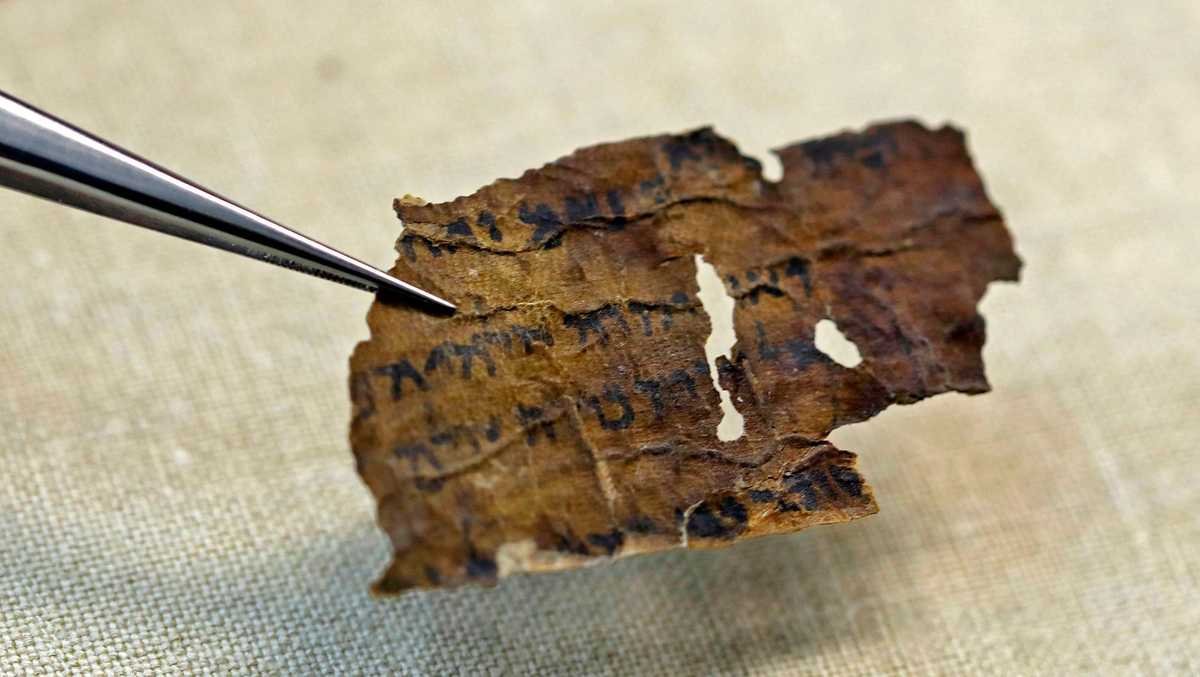Many of the Dead Sea Scrolls could be older than once thought, a new study suggests.According to Mladen Popović, lead author of the report published in PLOS One, the analysis used both traditional radiocarbon dating and new artificial intelligence to date the biblical manuscripts to around 2,300 years ago, CNN reports.The scrolls were first noticed by Bedouin shepherds in the Judean Desert, which is near the Dead Sea, in 1947. Since then, archaeologists have collected thousands of fragments from what are thought to be hundreds of manuscripts in caves in what’s now the West Bank of Palestine. They contain the earliest known texts from the Hebrew Bible.“The Dead Sea Scrolls were extremely important when they were discovered, because they completely changed the way we think about ancient Judaism and early Christianity,” Popović, who is also dean of the Faculty of Religion, Culture and Society at the University of Groningen in the Netherlands, told Jacopo Prisco for CNN. “They gave us a lot of information about what the text looked like back then.”Popović says the scrolls are like a time machine because they can reveal what people were reading, writing and thinking at the time. “They are physical, tangible evidence of a period of history that is crucial — whether you’re Christian, Jewish or don’t believe at all, because the Bible is one of the most influential books in the history of the world, so the scrolls allow us to study it as a form of cultural evolution,” he said.Almost none of the Dead Sea Scrolls have dates written on them. Scholars previously believed the manuscripts were written from the third century BCE to the second century CE.“But now, with our project, we have to date some manuscripts already to the end of the fourth century BCE,” Popović said. That means the earliest scrolls could be up to 100 years older than previously thought.Carbon dating is often used to pinpoint the age of documents like these. But some of the manuscripts were treated with castor oil in the 1950s in an attempt to preserve them, which interferes with the carbon dating process. So the team used new carbon dating to date some of the manuscripts, then trained an AI program called Enoch on those results. To test the program, they gave the AI 135 manuscripts without dates. It agreed with the estimates scholars made 79% of the time.”With the Enoch tool we have opened a new door into the ancient world, like a time machine, that allows us to study the hands that wrote the Bible,” Popović said in a statement. “Especially now that we have established, for the first time, that two biblical scroll fragments come from the time of their presumed authors.”Other scientists reacted to the results with a more cautious perspective.”The results of this study are very interesting, and presumably important, but not Earth-shattering,” Christopher Rollston, a professor and chair of biblical and Near Eastern languages and civilizations at The George Washington University, told Ben Turner at Live Science in an email. “Most of the conclusions of this article also dovetail with what the great palaeographers in the field, such as the late Frank Moore Cross, had already stated more than 60 years ago.”He added that Popović’s statement that the technology allows researchers to “study the hands that wrote the Bible” was “at the very least, gross hyperbole.” No manuscripts of the Hebrew Bible date to the First Temple period (around 1200 to 586 BCE), when the Bible was originally composed, or to the early parts of the Second Temple period (538 BCE to 70 CE), he said.Rollston also said AI should only be used to complement human tools in work like this.”Human handwriting, and all of its variations and idiosyncratic features, is a deeply human thing,” he said. “Machines can be helpful in isolating features of a script, but the presence of a gifted paleographer is at least as valuable as a machine-learning tool.”Brent Seales, the Alumni Professor of computer science at the University of Kentucky, who was not involved in the study, told CNN in an email that the approach taken by the authors seemed rigorous, even if it uses a small sample size. He agreed that AI should be used with caution, adding that “ like a fine wine, it should get better over time and with more samples.”
Many of the Dead Sea Scrolls could be older than once thought, a new study suggests.
According to Mladen Popović, lead author of the report published in PLOS One, the analysis used both traditional radiocarbon dating and new artificial intelligence to date the biblical manuscripts to around 2,300 years ago, CNN reports.
The scrolls were first noticed by Bedouin shepherds in the Judean Desert, which is near the Dead Sea, in 1947. Since then, archaeologists have collected thousands of fragments from what are thought to be hundreds of manuscripts in caves in what’s now the West Bank of Palestine. They contain the earliest known texts from the Hebrew Bible.
“The Dead Sea Scrolls were extremely important when they were discovered, because they completely changed the way we think about ancient Judaism and early Christianity,” Popović, who is also dean of the Faculty of Religion, Culture and Society at the University of Groningen in the Netherlands, told Jacopo Prisco for CNN. “They gave us a lot of information about what the text looked like back then.”
Popović says the scrolls are like a time machine because they can reveal what people were reading, writing and thinking at the time.
“They are physical, tangible evidence of a period of history that is crucial — whether you’re Christian, Jewish or don’t believe at all, because the Bible is one of the most influential books in the history of the world, so the scrolls allow us to study it as a form of cultural evolution,” he said.
Almost none of the Dead Sea Scrolls have dates written on them. Scholars previously believed the manuscripts were written from the third century BCE to the second century CE.
“But now, with our project, we have to date some manuscripts already to the end of the fourth century BCE,” Popović said. That means the earliest scrolls could be up to 100 years older than previously thought.
Carbon dating is often used to pinpoint the age of documents like these. But some of the manuscripts were treated with castor oil in the 1950s in an attempt to preserve them, which interferes with the carbon dating process. So the team used new carbon dating to date some of the manuscripts, then trained an AI program called Enoch on those results.
To test the program, they gave the AI 135 manuscripts without dates. It agreed with the estimates scholars made 79% of the time.
“With the Enoch tool we have opened a new door into the ancient world, like a time machine, that allows us to study the hands that wrote the Bible,” Popović said in a statement. “Especially now that we have established, for the first time, that two biblical scroll fragments come from the time of their presumed authors.”
Other scientists reacted to the results with a more cautious perspective.
“The results of this study are very interesting, and presumably important, but not Earth-shattering,” Christopher Rollston, a professor and chair of biblical and Near Eastern languages and civilizations at The George Washington University, told Ben Turner at Live Science in an email. “Most of the conclusions of this article also dovetail with what the great palaeographers in the field, such as the late Frank Moore Cross, had already stated more than 60 years ago.”
He added that Popović’s statement that the technology allows researchers to “study the hands that wrote the Bible” was “at the very least, gross hyperbole.”
No manuscripts of the Hebrew Bible date to the First Temple period (around 1200 to 586 BCE), when the Bible was originally composed, or to the early parts of the Second Temple period (538 BCE to 70 CE), he said.
Rollston also said AI should only be used to complement human tools in work like this.
“Human handwriting, and all of its variations and idiosyncratic features, is a deeply human thing,” he said. “Machines can be helpful in isolating features of a script, but the presence of a gifted paleographer is at least as valuable as a machine-learning tool.”
Brent Seales, the Alumni Professor of computer science at the University of Kentucky, who was not involved in the study, told CNN in an email that the approach taken by the authors seemed rigorous, even if it uses a small sample size. He agreed that AI should be used with caution, adding that “ like a fine wine, it should get better over time and with more samples.”










